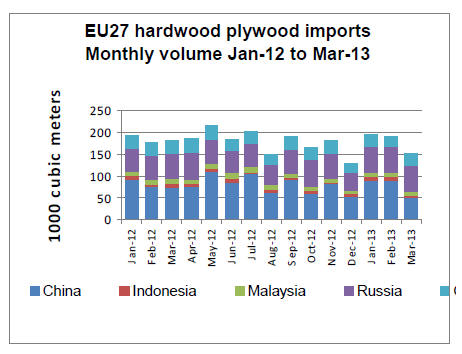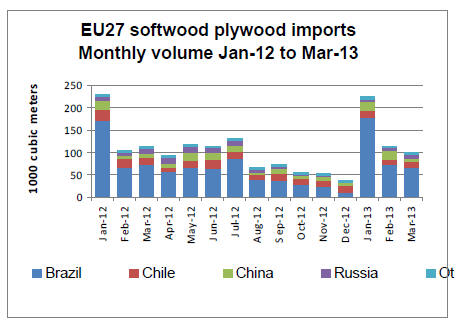|
Report
from
Europe
EU plywood imports reflect construction downturn and EUTR
Monthly data for EU27 hardwood plywood imports suggests that
European trade in this commodity is coming under pressure from the
combined effects of the recent slowdown in European construction and the
enforcement of the EU Timber Regulation (EUTR) from 3 March onwards (
see chart ).
The latest data 每 to the end of March 2013 每 is the first to record
trade levels immediately before and after the EUTR deadline.
The data shows a fall in imports in December 2012 每 a much sharper dip
than is usual in the run up to the holiday season 每 followed by a surge
in imports in January and February 2013. Then, between the second and
third months of the year, imports fell by over 20% to only 150,000 m3 in
March 2013. This is significantly lower than normal for the time of
year.
Overall the data supports the narrative that European consumption of
plywood is weakening with declining construction activity, particularly
since the middle of 2012.
However EUTR encouraged a surge in imports in the weeks before
enforcement, so that stocks built up in excess of market demand. This
surge tailed off following introduction of EUTR.

The data shows that there was a particularly large increase in imports
from China in January and February 2013, but that imports from this
country fell by 40% in March.
The main question now is whether the March downturn is indicative of a
long term trend or merely short-term indigestion after the rush of
imports in the opening weeks of 2013.
There*s some uncertainty over just how long it will take to work through
the excess stock of Chinese plywood built up in Europe in advance of
EUTR enforcement. In the latest TTJ article on the UK plywood market,
one importer claims that ※a lot of that stock has gone 每 I don*t think
there is as much as people think there is§. Another added: ※there have
been stocks, but holes are appearing. Supplies of thin panel in
particular are not plentiful§.
Larger Chinese manufacturers adapting quickly to EUTR
It*s still early days, but so far the signs are that the downturn in
imports from China may be short lived. The larger Chinese manufacturers
are already demonstrating strong capacity to adapt to the new market
requirements.
The most immediate change may be just a switch in the face veneers used
by these manufacturers, away from species perceived in Europe to be
※high risk§ (such as bintangor or Russian birch), in favour of species
perceived to be ※low risk§ such as dyed poplar or certified meranti or
sapele.
Some of the smaller manufacturers in China may well struggle now to
compete in the EU market as buyers focus more on those manufacturers
that have chain of custody and are geared up to provide the required
evidence of legality. These changes are already increasing prices of
Chinese plywood products to European buyers.
EUTR is tending to reinforce other commercial trends that were already
limiting opportunities for smaller manufacturers and encouraging higher
prices for Chinese plywood.
These include higher quality standards with imposition of the EU*s
Construction Products Regulation (CPR) from 1 July 2013 and rising
labour and material costs in China itself.
In coming months, China may become slightly less dominant in the EU
plywood market. However it*s likely to maintain its position as the
largest single supplier.
Chinese plywood prices may now be rising for EU buyers, but they remain
highly competitive. For example, European CIF prices for 18 mm C=BB/CC
Mixed Light Hardwood plywood from China were around $380/m3 in the last
quarter of 2012.
Prices for comparable Chinese plywood with an FSC certified sapele face
and eucalyptus core now stand at around $420-440/m3. Even these prices
are still $100/m3 less than those for 18 mm BB/CC meranti from Malaysia
and $150/m3 below prices for Indonesian lauan plywood.
Exporters in other countries wishing to regain market share for tropical
hardwood plywood in the EU market need to do more than provide new forms
of legality verification at a competitive price. They need to focus at
least as much on the considerable quality and technical performance
benefits of their products.
New opportunities might arise following introduction of the CPR which
implies much wider and more effective mandatory enforcement of CE
Marking standards, including conformance of structural plywood to the
EN13986 standard.
Malaysia sees short-term benefits from EUTR
European importers report that Malaysia has seen some short-term
benefit from implementation of EUTR, with demand for PEFC certified
BB/CC grades of meranti-faced plywood rising a little in recent months.
Some EU buyers appear at least temporarily to have switched away from
Chinese hardwood plywood products due to lack of confidence in
assurances offered on legal status of hardwoods imported into China.
In recent weeks, European importers have been able to source PEFC
certified Malaysian hardwood plywood without difficulty, although the
switch to Malaysia has meant they are paying significantly higher prices
than they used to in China.
Slowdown in imports of Indonesian plywood
Comparatively high prices are currently deterring European buying of
Indonesian plywood, despite these products being well known for their
quality and now arriving in the EU with V-Legal documents.
It*s notable that EU imports from Indonesia declined from 9800 m3 in
February 2013 to 4400 m3 in March 2013. This trend may be driven mainly
by weak European consumption, but could also be related to Indonesia*s
rolling out of the V-legal system for all exports to the EU during the
first quarter of 2013.
According to the German timber trade journal EUWID, most Indonesian
plywood imported into the EU was formerly classified under tariff code
44123190 which is subject to a 3.5% import tariff.
However more accurate information on species content supplied with the
V-legal documents has led to some product being reclassified as 44123110
subject to a higher tariff of 6.5%.
The latter tariff applies to plywood faced with various higher value
tropical hardwoods including several Asian species such as dark red
meranti, light red meranti, and white lauan.
Very slow European market for okoume plywood
Early optimism that EUTR might feed through into improved demand for
okoume plywood manufactured in Europe or in Africa has so far been
disappointed. Manufacturers of okoume plywood have been trying to force
through price increases in Europe in an effort to widen very tight
margins.
However European demand for okoume plywood remains very weak. There was
a brief increase in European buying in the opening months of the year,
but this has fallen away again following manufacturers* price rises
introduced from April onwards.
Okoume plywood consumption in the main markets of France and the
Netherlands has been very slow this year. While there are reports of
delivery delays for okoume plywood manufactured in Gabon, low
consumption has meant that supply has not been a significant issue for
the European trade.
European plywood manufacturers under intense pressure
EUWID report that Europe*s domestic plywood industry has been
struggling seriously in the face of mounting costs and the intense
competition from overseas suppliers. Key problems have been high
roundwood prices and wage costs relative to other parts of the world.
With the added pressure of weakening consumption in the European
construction sector, profit margins are now being reduced to
unsustainable levels. Some suppliers have been forced to file for
insolvency, while others have had to postpone or cancel plans for
investment in new plant and machinery.
According to EUWID, the problem has been especially difficult in the
European poplar plywood sector which added a significant amount of new
production capacity just before the economic downturn.
For example, one Spanish plywood producer completed two investment
projects in Spain and France in mid-2009 which boosted the group*s
poplar plywood manufacturing capacity from 60,000 m3 to 210,000 m3.
However this came on-stream just as consumption was falling and led to a
significant decline in prices and much lower margins across the whole
industry.
Europe*s okoume plywood market has also suffered badly from the
long-drawn out failure of the French producer Plysorol.
Various investors had shown an interest in the company, according to
EUWID primarily in order to take control of Plysorol*s concessions in
Gabon. After these efforts failed, the company eventually went into
liquidation in September 2012.
Since then the company*s remaining stocks have been sold off at a series
of auctions, the latest in May, undermining demand for other suppliers*
products.
Softwood plywood
EU imports of softwood plywood during the opening months of 2013
followed a slightly different pattern to the previous year (see Chart).
EUTR may have been partly responsible.

This year the usual January surge in imports on opening of the EU*s annual
quota was at the same level as in 2011.
Total imports in February 2013 were also at a similar level to February
2012, but with a larger volume from China offsetting a decline from
Chile. In March, after enforcement of EUTR, imports fell away quite
significantly, notably from China and Brazil.
By the end of March 2012, total softwood plywood imports into the EU for
the year had reached 441,000 m3. Around two thirds of the 650,000 m3
duty-free quota was already accounted for.
Of total imports during the first quarter of 2013, 72% was from Brazil, 9%
from Chile, 11% from China and 5% from Russia.
European consumption of softwood plywood is currently slow. Brazilian
exporters of elliotis pine plywood have been raising prices in response
to tight log supply and good plywood demand in the United States and
Caribbean.
However sales prices in Europe have been declining as importers are
struggling to sell on landed stocks. The usual seasonal increase in
demand in April and May has been much slower than in previous years.
* The market information above has been generously provided by the
Chinese Forest Products Index Mechanism (FPI)
|